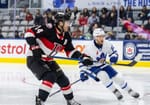The Leafs went on vacation, the Marlies played a home game, and the eyes of the Leafs press turned to the AHL for a brief moment. What are they saying about the Marlies?
They aren’t talking about the team, exactly. They are talking about the small number of players on the team who may one day become NHL players.
Kasperi Kapanen
First up, Sportsnet’s Chris Johnston talked to and about Kasperi Kapanen.
The hook here is that Kapanen doesn’t watch the Leafs. There is a tone to the start of this article that demands my sympathy for Kapanen being “left behind” in the AHL while the rest of the crew are lighting up the scoreboard in the NHL.
“Now I’m a Marlie and to be honest I don’t watch the Leafs games or anything,” Kapanen said Tuesday. “I don’t really follow them. Obviously, I’ll ask Willy how he played after the game. That’s about it.”
The article tells me that Kapanen believes he should have stuck with the Leafs this year just like Nylander, Brown and Hyman. Which is fair enough; all good hockey players need that level of self assurance and belief in themselves.
But then there is this:
Scouts who have watched him this year tend to agree with that point of view. There’s even a strong sentiment within the Leafs organization that he’s prepared to make the jump.
There is more in that vein, other quotes from other scouts, but there is some temporal distortion going on here. Kapanen may believe he was ready before now, and some scouts may believe he is ready now or in the near future, but you can’t backdate his development make him a tragic character. This is all vaguely reminiscent of the entire genre of poor Frank Corrado stories that flooded out when he made some public remarks about his situation.
The article suggests that Kapanen is in some sort of stasis mode while the Leafs go on remarkably healthy without him.
But Kapanen is not in stasis mode; he is not the same player now who performed fairly poorly for nine games last year in the NHL, and the article does go on to explore that in some detail:
Those close to [Kapanen] see more maturity in his second full year of professional hockey in North America. The Marlies are giving him huge minutes and trusting him to protect a lead in the dying seconds of a game.
He’d never previously been a penalty killer at any point in his life, but seems to be embracing the idea that the Leafs have a larger plan for him.
“This is my first year doing it and I think I’ve been doing a pretty good job of it,” said Kapanen. “So I guess I’m turning into a PK player now. That’s my future.”
You do not have to be close to him to see more maturity. You can see it in his game. His previous year in the AHL was marked by big highs of offensive brilliance and production, and long, long lulls of nothingness. There was no sign at all that he would be the guy the team would call on when the chips were down. He showed that he could be that guy in the WJC for Finland, but he did not show that later in the NHL.
He came back to the Marlies after his nine games in the NHL, last year and struggled to produce a consistent level of performance. He found himself healthy scratched in the first game of the playoffs.
That was then. Now Kapanen is very different, but one should not erase the reality of his past performance. He needed development, and he is showing an impressive level of growth in all areas of his game.
Kapanen on the penalty kill has been a work in progress, and it is progressing. Anyone who has watched the Marlies with their very aggressive short-handed style can see that the attempt is being made to mirror what the Leafs have with Connor Brown and Zach Hyman on the ice. Anyone who watched the Leafs play against Montréal, where Mitch Marner joined the penalty kill after Frederik Gauthier was ejected, knows what it looks like when a truly elite-level player plies that trade at high speed.
Meanwhile on the Marlies, they have a mediocre four short-handed goals for and a very poor penalty kill percentage that is 21st in the league. It is a work in progress, not a finished product, much like Kapanen himself. But if the end result is even a good fraction of what Marner can do, it will be worth it.
Kapanen might be the next man up to the Leafs as this article states. But he is not just spinning in circles on the Marlies; he is actively developing and learning and getting himself ready for the transition to a league where you have to be “on” all the time.
In the Marlies recent loss to the Wilkes-Barre/Scranton Penguins, they had ridden an outstanding goalie performance to a late third-period tie and were in line for a least a point against the best team in the Eastern Conference. Then Tom Sestito was allowed to walk in on a two on one (Frank Corrado) and win the game. Kapanen is the man who doesn’t seem to even know what to do defensively as the play develops, approaching the puck carrier and just backing off. Viktor Loov takes himself out of the play entirely. Watch at the 3:20 mark.
For all the highlight reel goals, and Kapanen has some beauties, there are also those kinds of plays to remind you that his place in the depth chart has been earned honestly. We should not feel sorry for the poor man whose friend is on the Leafs while he toils away riding the busses, we should applaud his hard work and dedication to his development that is moving him up that depth chart over the heads of older, more experienced players. He is earning that honestly.
When Kapanen gets his next NHL opportunity, he will be more ready to seize it.
Travis Dermott
David Alter of The Athletic did a piece on Travis Dermott.
So far, Dermott’s skill is evident in his first season with the Marlies. The 20-year-old recorded five assists in his first seven games. Despite having several players move on from last season’s franchise-best 114-point season, the Marlies started this season 6-1-0 with Dermott in the lineup.
“Travis had an excellent start to the season for us, he really established himself,” Marlies coach Sheldon Keefe said. “He has a strength of skating and lateral movements and he had an advantage early in the season and then he really did well with that.”
It’s always good when looking at a very small number of games to check the level of the competition. The Marlies opened the season with two wins against Utica, two against Manitoba, and both of those teams are now, many more games in, lower in the standings than Toronto. The Marlies did get a couple of early wins against better teams, but their start to the season was a nice, easy entry to AHL play for their rookies.
Dermott has seven assists in 22 games, all at even strength, and he’s played entirely with Viktor Loov. They are usually the third pair, and Dermott has slotted in below fellow rookie Andrew Nielsen on the depth chart.
That may be changing. The arrival of Frank Corrado on a conditioning stint has meant that Loov and Nielsen have been trading off shifts with the same partner where Nielsen gets the power play time and offensive focus while Loov picks up the defensive slack. Dermott has been taking regular shifts, and playing fairly well.
He hasn’t got Nielsen’s big rocket of a shot, and his point stats don’t look as exciting, but Dermott is learning to be a pro at a fast rate.
The loss on Wednesday to the Penguins was a bit of setback for Dermott as he was the culprit on the first goal (2:10 on the video above), making a terrible pass that went right onto the tape of Jake Guentzel, the man who famously scored twice in the first period of his first NHL game.
Dermott is a very interesting prospect, however, maybe the best future defender on the Marlies, but he’s not in sniffing range of the NHL yet, and his season has been rockier than that excellent start implies. The idea Alter floats that Dermott might replace Matt Hunwick next season or that he was about to be the Marlies best defenceman before his injury is unreasonably optimistic.
Dermott just turned 20 in December. If he needs more than the approximately 12 weeks left on this AHL season to develop into an NHLer, that’s not going to be a surprise.
Frank Corrado
Lance Hornby gives a straight up interview with Frank Corrado as part of his game coverage.
“Maybe in the third or fourth game, I caught myself trying to do too much. Today, I was trying to keep it simple. The more you do that, the more plays open up for you. It’s a good mindset to have. Seven games in 14 nights is a lot of hockey, but it’s good to get thrown in the fire like that, to sink or swim.”
Corrado got his first assist in his fourth game, Wednesday’s loss, on a goal by Tony Cameranesi (1:49 in the video above). He has played fairly well in this conditioning stint, and all reports I’ve seen agree with Keefe’s assessment:
Sheldon Keefe says Frank Corrado is a much better player than he was on AHL stint last season. Brought a lot of excitement to team.
— Kristen Shilton (@kristen_shilton) January 12, 2017
Corrado got caught as the sole defender on the two-on-one that won the game for the Penguins, and he took away the pass well enough, but the shot was too good for Garret Sparks.
Earlier in the game, Corrado was making some defensive zone errors, giving the puck away and failing to move it up ice. This is the area of his game that is lacking, and his offensive skill still lags well behind Connor Carrick.
One should expect Corrado’s game to be better after non-stop NHL practices along side extremely skilled defenders. He should be the obvious best man on the ice on the Marlies if he truly is an obvious NHL player in waiting. And while he has improved, if he were a left-handed defender, he would be on the Utica Comets right now, riding the elevator to the Canucks once in a while and failing to stick.
The desperate desire of people to see Corrado, Nielsen, Dermott or even and more unlikely, Justin Holl, make the jump to the NHL to replace the poor third pair on the Leafs is not enough to make those defenders the right choice right now for the Leafs roster. Remember when Loov and Rinat Valiev were just steps away? Sometimes the step never gets taken. But Valiev, right now, is better than all of those others, save perhaps, Corrado.
Dermott, like Kapanen, is playing some penalty kill minutes these days. This bodes well for both of them in the future. The Leafs power play is full up on very skilled players. A decent AHL offensive rate isn’t going to get anyone William Nylander’s or Nikita Zaitsev’s place on that power play. But the penalty kill is another story, and it might not cover them in glory, but it might get them to the NHL.
It has worked before. Ben Smith learned to kill penalties in the AHL for exactly that reason.




Comment Navigation & Markdown
Navigation
cc to focus on comments section
c next comment
x previous comment
z next unread comment
Inline Styles
Bold: **Text**
Italics: *Text*
Both: ***Text***
Strikethrough: ~~Text~~
Code: `Text` used as sarcasm font at PPP
Spoiler: !!Text!!